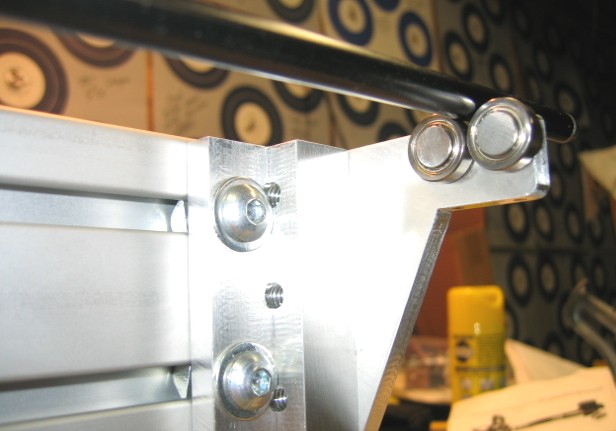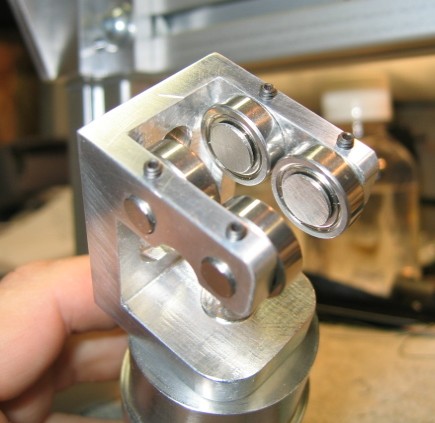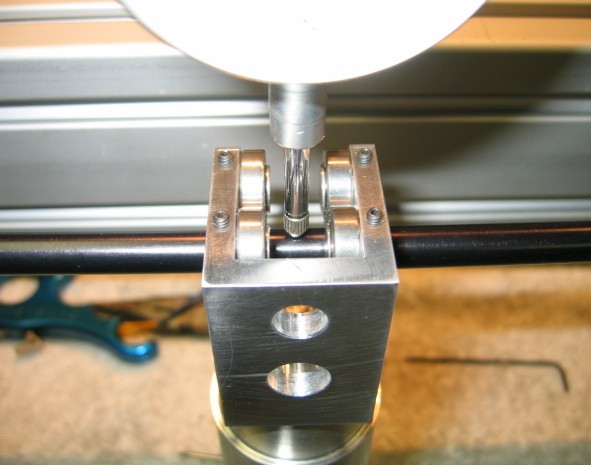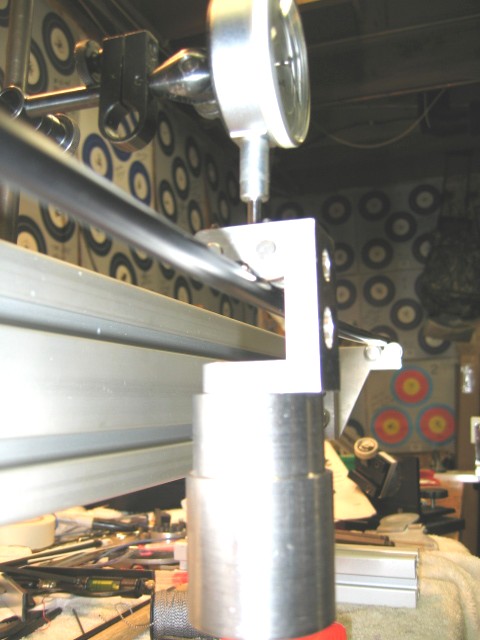JeffB, this spine's for you!
#1
Fork Horn
Thread Starter
Join Date: Feb 2003
Location: Kenosha, Wi USA
Posts: 499
JeffB had asked me a while ago if I ever got around to making a spine testing jig that I had mentioned I was going to build, and if I had any pics. We all know how busy we get and things get put on the back burner. For a year (or more). 
But I finally got around to making what I think is a damn nice spine tester, and extremely accurate as well. I'm sure it can't compare to the ultra precise laser type spine testers that Easton uses, but for a jig with a dial indicator I haven't seen any better.
Couple of things to think about when making a spine tester. I had seen several home-made versions similar to this one:
http://www.jamesmhill.com/Spine_Tester.html
Have a look at the pics and note the way the dial indicator is mounted BELOW the weight. That is a key factor in this design. After looking at several designs like this I thought it would be easy enough to make with some scrap aluminum I had laying around at work. I got to thinking about the standard weight of 880grams and how I was going to get to that amount for the weight.
I had a 1" travel dial indicator that I could use and I started tinkering with that and then the light bulb went on. When you press the plunger of the indicator and get near the 1" of travel, what brings it back to its starting point? A SPRING inside! That spring has a force, and in the designs where the indicator is below the weight- it is OPPOSING your downward weight. And the spring force isn't linear. The force increases as you stretch that internal "return spring". So I wanted to know how much force I was dealing with. It surprised me when I got near the 1" of travel it was approaching 100grams!
So in the designs where the dial indicator is mounted below the weight, you have a variance of your final downward weight depending on the deflection you're measuring. That 880gram weight could be off by more than 12% (880 down, 100 up) if the deflection is around an inch (at least with my indicator)- I would assume that others indicators are similar in construction. I suppose it would be ok for arrow-to-arrow comparisons, but if you're trying to actually measure the spine deflection amount it could be outta whack by quite bit I would imagine. The weaker the spine of the arrow your trying to meausure, the more the return spring is stretched as the deflection amount is greater and the more it would "help" the spine and it would seem stiffer than it really was. [:@]
Wow, that was surprising to me. So what to do? If you remove the back cover of the dial indicator, you can simply unhook the return spring. So I need to mount it above the shaft. There is enough "dead weight" in the plunger that the indicator works just fine without the spring if mounted above the shaft. The dead weight of the plunger just rides on top of the shaft ADDING to our hanging weight. So I simply measure the dead weight of the plunger on a accurate scale and it came out to just about 29.0 grams. Cool- now I knew my final hanging weight should be 851.0 grams to equal the correct 880 for the industry standard.
I have seen some weight "hooks" that hang on the shaft. I didn't want a hook that could possibly scratch into an expensive carbon arrow shaft, so I made a symmetrical hanging device that uses bearings on each side of the indicator. That way I know my indicator is measuring the lowest part of the deflection. If the hanging apparatus was off to one side of the indicator plunger (like only using two bearings) I could not be sure of getting the indicator in the correct spot for the full deflection amount. Thousandths of an inch make a difference.
The outside supports also use a couple of ball bearings. Currently at 28" span at the inside edges of the bearings, but I'll mill some more holes in one inch increments for spans of 26", 24", etc.... I have some 27.5" arrows with fletching on them, and while I couldn't measure the industry standard 28" span on them anymore, I could at least do arrow-to-arrow comparisons at 24". I would estimate that I'm withing .010" of the span as I had a couple of thousandths of play in the bolt holes on each end bracket. Close enough for me!
I would estimate that I'm withing .010" of the span as I had a couple of thousandths of play in the bolt holes on each end bracket. Close enough for me!
Now I can exactly see how consistent my arrows are from advertised spine and from arrow to arrow. Thanks for prodding me along Jeff!






But I finally got around to making what I think is a damn nice spine tester, and extremely accurate as well. I'm sure it can't compare to the ultra precise laser type spine testers that Easton uses, but for a jig with a dial indicator I haven't seen any better.
Couple of things to think about when making a spine tester. I had seen several home-made versions similar to this one:
http://www.jamesmhill.com/Spine_Tester.html
Have a look at the pics and note the way the dial indicator is mounted BELOW the weight. That is a key factor in this design. After looking at several designs like this I thought it would be easy enough to make with some scrap aluminum I had laying around at work. I got to thinking about the standard weight of 880grams and how I was going to get to that amount for the weight.
I had a 1" travel dial indicator that I could use and I started tinkering with that and then the light bulb went on. When you press the plunger of the indicator and get near the 1" of travel, what brings it back to its starting point? A SPRING inside! That spring has a force, and in the designs where the indicator is below the weight- it is OPPOSING your downward weight. And the spring force isn't linear. The force increases as you stretch that internal "return spring". So I wanted to know how much force I was dealing with. It surprised me when I got near the 1" of travel it was approaching 100grams!
So in the designs where the dial indicator is mounted below the weight, you have a variance of your final downward weight depending on the deflection you're measuring. That 880gram weight could be off by more than 12% (880 down, 100 up) if the deflection is around an inch (at least with my indicator)- I would assume that others indicators are similar in construction. I suppose it would be ok for arrow-to-arrow comparisons, but if you're trying to actually measure the spine deflection amount it could be outta whack by quite bit I would imagine. The weaker the spine of the arrow your trying to meausure, the more the return spring is stretched as the deflection amount is greater and the more it would "help" the spine and it would seem stiffer than it really was. [:@]
Wow, that was surprising to me. So what to do? If you remove the back cover of the dial indicator, you can simply unhook the return spring. So I need to mount it above the shaft. There is enough "dead weight" in the plunger that the indicator works just fine without the spring if mounted above the shaft. The dead weight of the plunger just rides on top of the shaft ADDING to our hanging weight. So I simply measure the dead weight of the plunger on a accurate scale and it came out to just about 29.0 grams. Cool- now I knew my final hanging weight should be 851.0 grams to equal the correct 880 for the industry standard.
I have seen some weight "hooks" that hang on the shaft. I didn't want a hook that could possibly scratch into an expensive carbon arrow shaft, so I made a symmetrical hanging device that uses bearings on each side of the indicator. That way I know my indicator is measuring the lowest part of the deflection. If the hanging apparatus was off to one side of the indicator plunger (like only using two bearings) I could not be sure of getting the indicator in the correct spot for the full deflection amount. Thousandths of an inch make a difference.
The outside supports also use a couple of ball bearings. Currently at 28" span at the inside edges of the bearings, but I'll mill some more holes in one inch increments for spans of 26", 24", etc.... I have some 27.5" arrows with fletching on them, and while I couldn't measure the industry standard 28" span on them anymore, I could at least do arrow-to-arrow comparisons at 24".
 I would estimate that I'm withing .010" of the span as I had a couple of thousandths of play in the bolt holes on each end bracket. Close enough for me!
I would estimate that I'm withing .010" of the span as I had a couple of thousandths of play in the bolt holes on each end bracket. Close enough for me! Now I can exactly see how consistent my arrows are from advertised spine and from arrow to arrow. Thanks for prodding me along Jeff!





#3
Join Date: Feb 2003
Location: Oakland Md. USA
Posts: 337
Jim, nice job!! I have a question. With aluminum shafts I have been told that the weld
area on the shaft is the stiffest and the heaviest spot on the shaft. This is were I try
and put my cock vane to make my arrows group more consistant together. Somewhat
simular to what I believe Tru-Flight arrow Co. does. I float my raw shaft arrows in my
bath tub with some soap added to the water and the shafts do in deed rotate in the
water to the same spot, which I assume is with the weld (or heavy portion) of the
arrow downward in the water. My question here is with your spine tester, can you
tell where the weld is on aluminum shafts by the deflection?
area on the shaft is the stiffest and the heaviest spot on the shaft. This is were I try
and put my cock vane to make my arrows group more consistant together. Somewhat
simular to what I believe Tru-Flight arrow Co. does. I float my raw shaft arrows in my
bath tub with some soap added to the water and the shafts do in deed rotate in the
water to the same spot, which I assume is with the weld (or heavy portion) of the
arrow downward in the water. My question here is with your spine tester, can you
tell where the weld is on aluminum shafts by the deflection?
#5
Join Date: Feb 2003
Location:
Posts: 2,413
Black Frog, that is an amazing spine tester. Looks like you'd have to charge about $1000 if you wanted to sell one. 
I love the design. When I was building mine, I did quite a bit of research and had read somewhere about removing the spring and mounting the dial indicator on the top. After thinking about it, I realized that I had no need to know the actual spine, that comparing arrows to each other was sufficient for my use, so I took the easier route. Mounting the weight below the arrow is a challenge and I wouldn't even want to try to make the gizmo you created. I also tried to imagine the amount that little spring would affect a 2 lb weight. I don't think it's much - especially on the stiffer spines. After looking at a few dial indicators, I realized they don't all have the same spring tension. You can choose one with less pressure. I'm not sure how far mine is off, but most .034 arrows hover right around the .034 mark.
I also tried to imagine the amount that little spring would affect a 2 lb weight. I don't think it's much - especially on the stiffer spines. After looking at a few dial indicators, I realized they don't all have the same spring tension. You can choose one with less pressure. I'm not sure how far mine is off, but most .034 arrows hover right around the .034 mark.
I used 3/4" cabinet grade plywood with common hardware brackets. With the dial indicator it cost about $30 and an hour of my time. It works, but is no where near the tool you made. Wanna trade?


I love the design. When I was building mine, I did quite a bit of research and had read somewhere about removing the spring and mounting the dial indicator on the top. After thinking about it, I realized that I had no need to know the actual spine, that comparing arrows to each other was sufficient for my use, so I took the easier route. Mounting the weight below the arrow is a challenge and I wouldn't even want to try to make the gizmo you created.
 I also tried to imagine the amount that little spring would affect a 2 lb weight. I don't think it's much - especially on the stiffer spines. After looking at a few dial indicators, I realized they don't all have the same spring tension. You can choose one with less pressure. I'm not sure how far mine is off, but most .034 arrows hover right around the .034 mark.
I also tried to imagine the amount that little spring would affect a 2 lb weight. I don't think it's much - especially on the stiffer spines. After looking at a few dial indicators, I realized they don't all have the same spring tension. You can choose one with less pressure. I'm not sure how far mine is off, but most .034 arrows hover right around the .034 mark. I used 3/4" cabinet grade plywood with common hardware brackets. With the dial indicator it cost about $30 and an hour of my time. It works, but is no where near the tool you made. Wanna trade?

#6
Nice Job! I am always in amazement at the devices that some of you have the skills to put together. That "shop" of yours is pretty impressive as well. I would feel quite a sense of accomplishment to have all of those excellent scoring targets surrounding me as I work.
#7
Fork Horn
Thread Starter
Join Date: Feb 2003
Location: Kenosha, Wi USA
Posts: 499
Aluminum shafts are not welded, they are seemless and drawn through many dies from much larger tubing.
SA, I agree on stiff spines you wouldn't notice much difference. But I was surprised on how much that spring force was as I approached the full travel. Since I deal with youth/light poundage bows and arrows I occasionally have to mess around with light spined arrows. Do I want to trade? ummmmm.... not just yet.

With the bearings on both ends and on the hanging weight, it's very smooth on the rotation of the arrow. I tinkered with my indoor arrows on the tester last night for the first time. They were all within .004" of each other for deflection, but the fun thing was seeing the stiff spot on a few of the shafts. Some had no stiff side that I could see, but a couple of the shafts did a .002-.003" wobble of the deflection as the shaft was rotated.
I'll admit I'm very fortunate to have all the toys I do. My basement is better equipped than most any archery shop I've been in.

#8
Very nice , It would be nice if sometime in the future you could post some variance results , of say an alluminum shaft, compared to an acc , compared to an all carbon . Bet the results would suprise , especialy if they had some useage on them .
#10
Fork Horn
Thread Starter
Join Date: Feb 2003
Location: Kenosha, Wi USA
Posts: 499
Aluminum shafts are not welded, they are seemless


